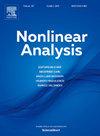Hypergraph p-Laplacian regularization on point clouds for data interpolation
IF 1.3
2区 数学
Q1 MATHEMATICS
引用次数: 0
Abstract
As a generalization of graphs, hypergraphs are widely used to model higher-order relations in data. This paper explores the benefit of the hypergraph structure for the interpolation of point cloud data that contain no explicit structural information. We define the -ball hypergraph and the -nearest neighbor hypergraph on a point cloud and study the -Laplacian regularization on the hypergraphs. We prove the variational consistency between the hypergraph -Laplacian regularization and the continuum -Laplacian regularization in a semisupervised setting when the number of points goes to infinity while the number of labeled points remains fixed. A key improvement compared to the graph case is that the results rely on weaker assumptions on the upper bound of and . To solve the convex but non-differentiable large-scale optimization problem, we utilize the stochastic primal–dual hybrid gradient algorithm. Numerical experiments on data interpolation verify that the hypergraph -Laplacian regularization outperforms the graph -Laplacian regularization in preventing the development of spikes at the labeled points.
点云的超图p-拉普拉斯正则化用于数据插值
超图作为图的一种推广,被广泛用于数据中高阶关系的建模。本文探讨了超图结构在不包含明确结构信息的点云数据插值中的优势。定义了点云上的n球超图和n近邻超图,研究了它们的p-拉普拉斯正则化问题。证明了在半监督条件下,当点的数目n趋于无穷而标记点的数目保持不变时,超图p-拉普拉斯正则化与连续体p-拉普拉斯正则化之间的变分一致性。与图情况相比,一个关键的改进是,结果依赖于对n和kn的上界的较弱假设。为了解决凸但不可微的大规模优化问题,我们采用了随机原始-对偶混合梯度算法。数据插值的数值实验验证了超图p-拉普拉斯正则化在防止标记点处出现尖峰方面优于图p-拉普拉斯正则化。
本文章由计算机程序翻译,如有差异,请以英文原文为准。
求助全文
约1分钟内获得全文
求助全文
来源期刊
CiteScore
3.30
自引率
0.00%
发文量
265
审稿时长
60 days
期刊介绍:
Nonlinear Analysis focuses on papers that address significant problems in Nonlinear Analysis that have a sustainable and important impact on the development of new directions in the theory as well as potential applications. Review articles on important topics in Nonlinear Analysis are welcome as well. In particular, only papers within the areas of specialization of the Editorial Board Members will be considered. Authors are encouraged to check the areas of expertise of the Editorial Board in order to decide whether or not their papers are appropriate for this journal. The journal aims to apply very high standards in accepting papers for publication.

 求助内容:
求助内容: 应助结果提醒方式:
应助结果提醒方式:


